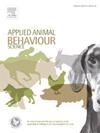The effects of owner-cat interaction on oxytocin secretion in pet cats with different attachment styles
IF 2.2
2区 农林科学
Q1 AGRICULTURE, DAIRY & ANIMAL SCIENCE
引用次数: 0
Abstract
The caretaking and interactive style of owners affect the behavioral health of pets. Research has indicated that attachment style is correlated to the social-cognitive ability and behavioral health of dogs, and oxytocin might be involved in the human-dog affiliative social interaction and emotional attachment. Studies that evaluate the relationship between attachment behavior, owner-cat interaction, and the potential roles of oxytocin are non-existent in pet cats. To address the current gap in knowledge, we recruited 30 pet cats of different attachment styles, as determined by the secure base test (SBT) and observed behaviors of the cats and owners during the free owner-cat interaction. Salivary samples were collected in cats before and after the owner-cat interactions for the detection of oxytocin. Additionally, a questionnaire was conducted to collect individual and behavior-related information of cats. Oxytocin release during free-owner-cat interaction varied in cats of different attachment styles. Oxytocin increased in securely attached cats (P = 0.03) whereas it tended to decrease in cats with an anxious attachment (P = 0.08). The baseline salivary oxytocin in cats of anxious attachment was at higher level (P = 0.03) than securely attached cats. Cats of different attachment styles interacted differentially with their owners (P = 0.02). Overall, securely attached cats initiated more interactions, showed more approach-hovering behavior and fewer escape attempts, and their owners exhibited less forced interactions in comparison with owners of insecurely attached cats. Cat approach-hovering behavior was positively correlated to an increase in oxytocin during free owner-cat interaction (P < 0.01) and negatively correlated to the baseline oxytocin (P = 0.01). Cats with secure attachment style also showed fewer behavioral problems and had lower fear score (P < 0.01) compared to insecurely attached cats. In summary, we found that cats of different attachment styles varied in their occurrence of behavioral problems, and exhibited different interactive style with owners and change of oxytocin during owner-cat interaction which is likely due to the varied basal oxytocin in cats of different attachment styles. The reason for the varied basal oxytocin levels in cats of different attachment styles requires further study. The results of the current study increased our understanding of the relationship of human-cat interaction and cat attachment behavior, and the oxytocin-related endocrinal mechanism that might be underlining the emotional connection between pet cats and owners.
求助全文
约1分钟内获得全文
求助全文
来源期刊

Applied Animal Behaviour Science
农林科学-行为科学
CiteScore
4.40
自引率
21.70%
发文量
191
审稿时长
18.1 weeks
期刊介绍:
This journal publishes relevant information on the behaviour of domesticated and utilized animals.
Topics covered include:
-Behaviour of farm, zoo and laboratory animals in relation to animal management and welfare
-Behaviour of companion animals in relation to behavioural problems, for example, in relation to the training of dogs for different purposes, in relation to behavioural problems
-Studies of the behaviour of wild animals when these studies are relevant from an applied perspective, for example in relation to wildlife management, pest management or nature conservation
-Methodological studies within relevant fields
The principal subjects are farm, companion and laboratory animals, including, of course, poultry. The journal also deals with the following animal subjects:
-Those involved in any farming system, e.g. deer, rabbits and fur-bearing animals
-Those in ANY form of confinement, e.g. zoos, safari parks and other forms of display
-Feral animals, and any animal species which impinge on farming operations, e.g. as causes of loss or damage
-Species used for hunting, recreation etc. may also be considered as acceptable subjects in some instances
-Laboratory animals, if the material relates to their behavioural requirements
 求助内容:
求助内容: 应助结果提醒方式:
应助结果提醒方式:


